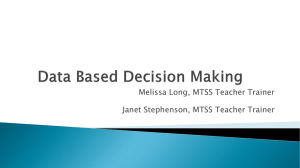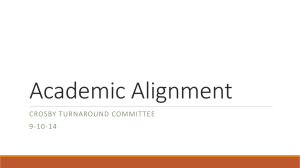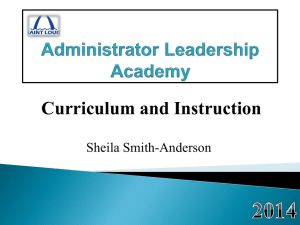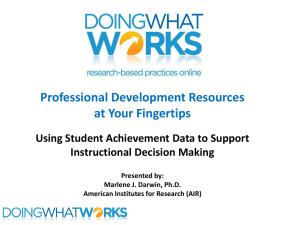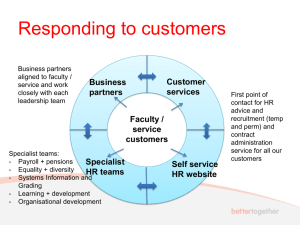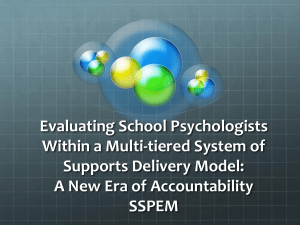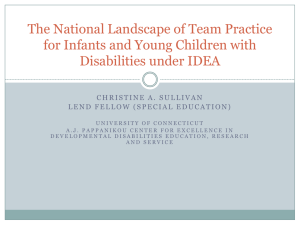pptx - Florida Problem Solving & Response to Intervention Project
advertisement
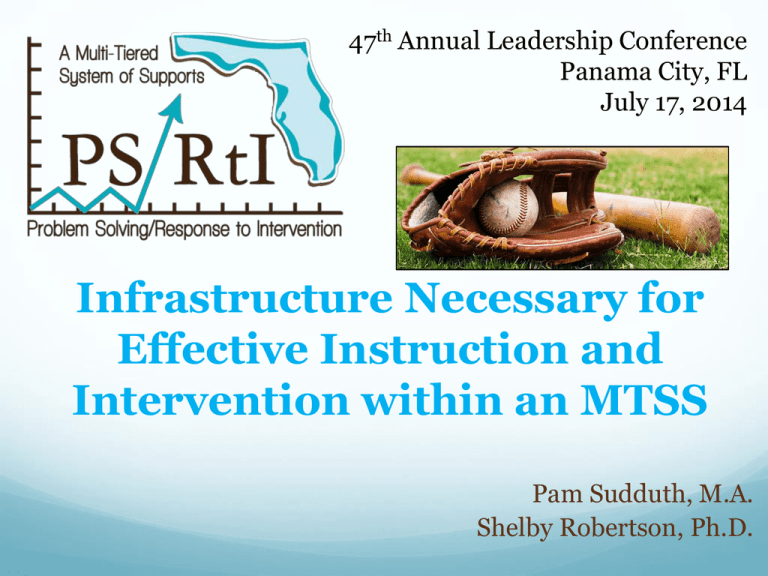
47th Annual Leadership Conference Panama City, FL July 17, 2014 Infrastructure Necessary for Effective Instruction and Intervention within an MTSS Pam Sudduth, M.A. Shelby Robertson, Ph.D. Day 1 Intensive Intervention: Purpose, foci, and implications Best practices for intensifying Tier 1 core instruction Universal Design for Learning (UDL) Day 2 Applying a continuum of support to address high probability and high intensity barriers to student engagement and learning Problem-solving necessary to design and implement effective intensive intervention Planning for Intensive Intervention Day 3 Problem-solving around an individual student focusing on technology Blue=Day 1 Yellow=Days 2 and 3 Green=All Days Barriers to Implementation • • • • • • • • • • • Time Resources (Materials/personnel) Collaboration Support Fidelity/Consistency/Accountability Lack of knowledge/lack of PD Buy in Resistance to change Infrastructure Unclear mission/vision Silos Support for Implementation • • • • • • • • • Support from the top PD Examples Resources Technical assistance Strategies This PD for entire district Continuation of this PD—Days 4 and 5 A way to document interventions Foundation Since 2004, Florida has engaged in continuous efforts to determine how systematic problem solving and the RtI framework integrate the various elements of Florida’s education system. Foundational Beliefs 1. Research-based instruction and evidence-based practices 2. Differentiated instruction to meet individual learning needs 3. Reliable, valid, and instructionally relevant assessments 4. Ongoing, systematic problem solving consistently utilized 5. Student data guides meaningful decision making 6. Professional development and follow-up coaching to ensure effective instruction 7. Actively engaged administrative leadership for data-based decision making is inherent to the school culture 8. All stakeholders are part of one proactive and seamless educational system Critical Elements for Infrastructure to Implement and Sustain MTSS 1. Leadership that connects the MTSS framework district and school improvement efforts 2. Alignment of policies and procedures across the continuum from state to classroom 3. Utilize a problem-solving process to support planning and implementation of a MTSS 4. Collaborative partnerships with all stakeholders 5. User-friendly data systems for supporting decision-making 6. Coaching supports to assist school team and staff problem-solving efforts 7. Ongoing data-driven professional development that align to student outcomes 8. Communicating outcomes with stakeholders 9. Celebrating success frequently The Game Plan Participants will engage in open discussions regarding the critical infrastructure that is necessary to support instruction/intervention design and implementation within a multi-tiered system of support. systemic supports effective teaming roles and responsibilities resource mapping Build the Bench What We Know… Each district (and school within each district) is unique and has its own “DNA”… What works in one does not necessarily work in another. Systemic Supports A multi‐tiered system of supports involves the systematic use of assessment data to most efficiently allocate resources in order to improve learning for all students. Catcher Directs and leads other players in a defensive way Data, Data, Data “It is a capital mistake to theorize before one has data. Insensibly one begins to twist facts to suit theories, instead of theories to suit facts.” Sir Arthur Conan Doyle (1859-1930) Utilizing Data Data are used to: • Identify students in need of intensive support Historical data, screening data, EWS • Understand student needs Diagnostic assessment data, learning scales, Discovery Ed., etc. • Monitor student progress Progress monitoring data: academic, behavior, engagement • Evaluate effectiveness of tiered intervention support Program evaluation data: Academic, behavior, engagement Using Data to Understand Student Needs Every system is perfectly aligned for the results it gets. ~Adapted from The Practice of Adaptive Leadership Utilizing Data Data will lead you to the changes you need to make… Reflection Are the decisionmaking processes in your district/school allowing for effective implementation of a MTSS? What barriers are hindering effective implementation of a MTSS? Baseball Fielding Positions Pitcher, Catcher, First Baseman, Second Baseman, Third Baseman, Shortstop, Left Fielder, Center Fielder, Right Fielder – Essential to the Game Effective Teaming Strong teams are essential to retaining and sustaining teachers. If a team is effective, then people learn from each other. Teaming Structures School-Based Leadership Team Literacy Leadership Teams Content Area Teams Specialist Teams Manager Responsible for strategy on the field and team leadership School Based Leadership Team • Determine and monitor school-wide learning and development goals Tier 1- Common issues (school-wide, grade-level, teacher teams and classroom) Consider how to integrate supports with other school-wide intervention or initiatives and monitor effectiveness. Tier 2- Develop weekly or bi-weekly support lists to identify groups of student with common needs that require problem-solving to moderate intensity Tier 3- Monitor effectiveness Determine students that require more intensive individualized problem-solving and supports (through Specialist Team) • Develop action plans to meet school improvement goals (e.g., SIP) Allocate the resources needed to fully implement instructional and intervention plans Manage and coordinate efforts between all school teams Barriers High intensity barrier• significant impact on individual student engagement and learning (e.g., small group & individual instruction, DI, aligned with learning needs) High probability barrier• wide-spread or common barriers that impact many students’ engagement and learning (e.g., integrate strategies that support cognitive processing through academic instruction, DI, provide adequate instructional time) Buckets of Barriers High Intensity Instruction Curriculum Environment Learner High Probability Instruction Curriculum Environment Learner Across Multiple Domains High Intensity Instruction Curriculum Environment High Probability Learner Tier 3 Barriers Instruction Curriculum Environment Learner Tiers 1 and 2 Barriers Multi-faceted needs of students Teaming Structures School-Based Leadership Team Literacy Leadership Teams Content Area Teams Specialist Teams Superficial or Authentic? Pinch Hitter/Runner or Designated Hitter Skilled players on the team Literacy Leadership Team (LLT) The purpose of the Literacy Leadership Team is to create capacity of literacy knowledge The team… Utilizes the problem solving framework Committed to ongoing work outside of regular meeting times Highly visible, staying connected with each other, the school site and the community Focused on manageable initiatives in an effort to enhance student learning Represents a cross-section of all members of the school (administrator, grade level or department representatives, special area teachers, support personnel) Establishes and adheres to ground rules for meetings (balancing conversation, honoring all ideas, listening, common goals) Structures work using a literacy plan Celebrates success ~Comprehensive Research-Based Reading Plan, Florida DOE Teaming Structures School-Based Leadership Team Literacy Leadership Teams Content Area Teams Specialist Teams Superficial or Authentic? Starting Pitcher Someone you can count on to get the job done Content Area Teams Analyze student data around the content area goals Implement instructional and intervention plans with fidelity to achieve established content area goals Utilize allocated resources Collect and analyze student data to determine student response to intervention Recommend programming changes to leadership team as necessary Engage in professional development which allows for continuous improvement Lesson Study Research shows that… Common team planning time is the single most significant factor in determining the level of implementation and the academic achievement gains shown by teams. ~Teaming With Purpose: Unleashing the Potential (http://education.jhu.edu/PD/newhorizons/lifelo nglearning/adolescence/articles/teamingwithpur poseunleashingthepotential/) "Students will not succeed if faced with a group of teachers whose work together is disjointed, disconnected, or, in some cases, dysfunctional.“ http://www.educationworld.com/a_admin/admi n/admin408_a.shtml#sthash.214Ns7uE.dpuf Teaming Structures School-Based Leadership Team Literacy Leadership Teams Content Area Teams Specialist Teams Superficial or Authentic? Relief Pitcher or Left Handed Specialist Expected to perform for a short period of time – provides the support needed to get the job done Specialist Teams Effective intensive intervention planning occurs within collaborative, specialist teams, which include team members with personal knowledge of the student and relevant and specialized academic and behavior expertise. (related to data analysis, student learning, engagement, curriculum, instruction, technology, and resource allocation) Specialist Teams Utilize a problem solving process to identify barriers and inform the intensity of instruction and set goals Collect and review ongoing progress monitoring data to evaluate the effectiveness of support Understand core instructional goals and plan interventions explicitly to support students’ achievement of those goals Develop action plans (with all stakeholders) to address identified barriers to meeting core goals Specialist Teams Implement individualized action plans to address identified barriers to meeting core goals Implement intervention plans with fidelity Collect and analyze student data to determine the student’s response to intervention Evaluate intervention response (with all stakeholders) Make adjustments to intervention plans as indicated by the student data Reflection Are teams in your school/district superficial or authentic? Are teams sustainable? Roles and Responsibilities Umpires Enforces the rules of the game and the grounds, makes judgment calls on plays, and handles the disciplinary actions Roles and Responsibilities The Role of District Leadership: Allocate resources Support the design of school schedules Evaluate the effectiveness of tiered interventions as a whole, and Provide feedback to schools The Role of School Leadership: Design the master schedule Allocate sufficient resources Monitor the effectiveness of tiered interventions as a whole, and Provide feedback to intervention providers and planning teams The Role of the Coach: Guide individuals and teams to build their capacity Guide the planning and implementation of intensive interventions Assist with effective collaboration skills, coaching efficient problem solving techniques and providing effective continuous professional development. Coach on a continuum – scaffold learning approach Roles and Responsibilities Role of Core Instruction Providers: Identify high probability and high intensity barriers to student achievement Plan and implement core instruction Collaborate with intervention providers to ensure integration and alignment of instruction and intervention Evaluate effectiveness of instruction and interventions Provide input to SBLT Role of Intervention Specialist: Work with core instructional providers to identify barriers to learning and engagement Collaborate with core instructional providers to ensure integration and alignment of intervention strategies and supports with core instruction Manage the implementation of Tier 3 intervention plans and actively support core instructional providers’ integration of effective intervention strategies and supports Monitor individual student’s response to intervention and make timely changes to intervention strategies and supports as needed. Reflection Is communication and collaboration supported? Are members of the team(s) building capacity individually? Resource Mapping Starting Line Up The starters are usually the best players on the team Resource Mapping What currently is available to achieve goals and address problems? What else is needed to achieve goals and address problems? Resource Mapping Analyzes to clarify gaps and recommend priorities for filling gaps related to programs and services and deploying, redeploying, and enhancing resources Identifying needs for making infrastructure and systemic improvements and changes Clarifying opportunities for achieving important functions by forming and enhancing collaborative arrangements Resource Mapping in Stages “Who’s Who” and what do they do? List of programs, activities, services, materials, etc. Map the dollars and related resources Reflection How does your school/district effectively map resources? How can you address barriers to implementing MTSS effectively through resource mapping? Evaluation of Key Components Resources Build Capacity New Vision Contact Information Pam Sudduth, M.A. Shelby Robertson, Ph.D. PS-RtI Project, Learning and Development Facilitator of Literacy PS-RtI Project, Learning and Development Facilitator of Mathematics psudduth@usf.edu srobertson@usf.edu (727) 421-0590 321-246-6550
